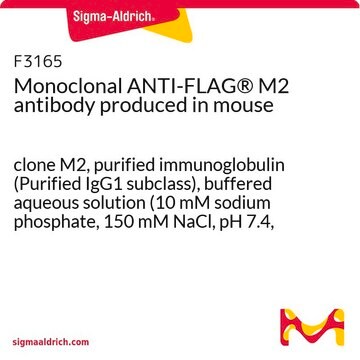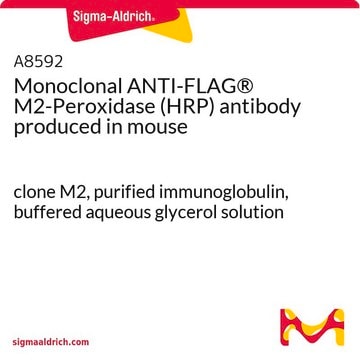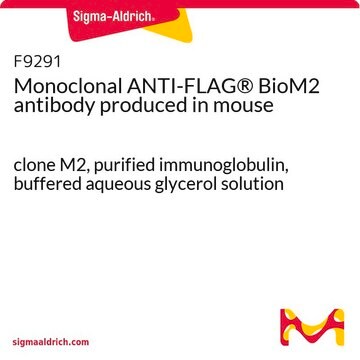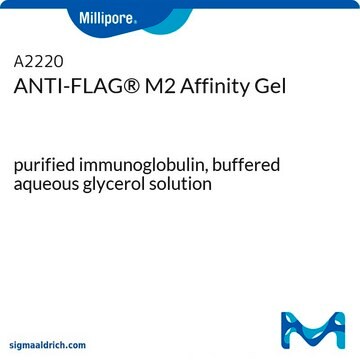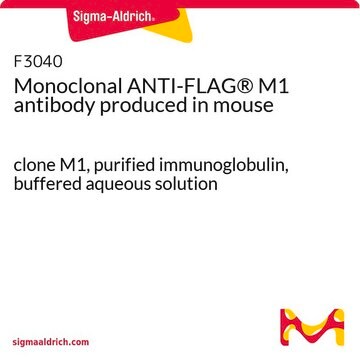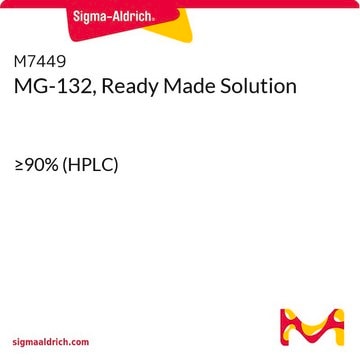Product A9594, Monoclonal ANTI-FLAG® M2-Cy3™ antibody produced in mice, is mouse IgG1. Theoretically, it will be recognized by the anti-mouse IgG secondary antibody. However, Product A9594 is already conjugated with Cy3 so a secondary antibody is not needed for detection.
Kluczowe dokumenty
A9594
Monoclonal ANTI-FLAG® M2-Cy3™ antibody produced in mouse
clone M2, purified immunoglobulin, buffered aqueous solution (Supplied as a solution in 10 mM sodium phosphate)
Synonim(y):
Monoclonal ANTI-FLAG® M2 antibody produced in mouse, Anti-ddddk, Anti-dykddddk
Wybierz wielkość
2720,00 zł
Wybierz wielkość
About This Item
2720,00 zł
Polecane produkty
pochodzenie biologiczne
mouse
białko sprzężone
CY3 conjugate
forma przeciwciała
purified immunoglobulin
rodzaj przeciwciała
primary antibodies
klon
M2, monoclonal
Formularz
buffered aqueous solution (Supplied as a solution in 10 mM sodium phosphate)
reaktywność gatunkowa
all
stężenie
~1 mg/mL
metody
direct immunofluorescence: 10 μg/mL using mammalian cells fixed with methanol:acetone
izotyp
IgG1
sekwencja immunogenna
DYKDDDDK
Warunki transportu
dry ice
temp. przechowywania
−20°C
Szukasz podobnych produktów? Odwiedź Przewodnik dotyczący porównywania produktów
Powiązane kategorie
Opis ogólny
Zastosowanie
Western Blotting (1 paper)
Learn more product details in our FLAG® application portal.
Postać fizyczna
Uwaga dotycząca przygotowania
Inne uwagi
Informacje prawne
Nie możesz znaleźć właściwego produktu?
Wypróbuj nasz Narzędzie selektora produktów.
Kod klasy składowania
10 - Combustible liquids
Temperatura zapłonu (°F)
Not applicable
Temperatura zapłonu (°C)
Not applicable
Wybierz jedną z najnowszych wersji:
Certyfikaty analizy (CoA)
Nie widzisz odpowiedniej wersji?
Jeśli potrzebujesz konkretnej wersji, możesz wyszukać konkretny certyfikat według numeru partii lub serii.
Masz już ten produkt?
Dokumenty związane z niedawno zakupionymi produktami zostały zamieszczone w Bibliotece dokumentów.
Klienci oglądali również te produkty
-
A9594(FLAG M2 Cy3標識)の抗体は抗マウスIgGの2次抗体に認識されますか。
1 answer-
Helpful?
-
Active Filters
Nasz zespół naukowców ma doświadczenie we wszystkich obszarach badań, w tym w naukach przyrodniczych, materiałoznawstwie, syntezie chemicznej, chromatografii, analityce i wielu innych dziedzinach.
Skontaktuj się z zespołem ds. pomocy technicznej

